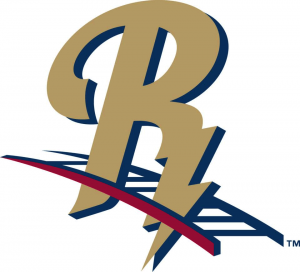When I first saw the logo for the Scranton/Wilkes-Barre RailRiders, which features a porcupine riding a rail, one obvious question leapt to my mind: Where the heck did a porcupine riding a rail come from? Turns out I’m not the only one. I spoke with the team’s president and general manager Rob Crain, and here’s what he had to say:
“I’ve talked to a lot of folks about our name and our colors, and the main question you get is, ‘Where the heck did a porcupine riding a rail come from?’”
 The rail aspect of the logo makes perfect sense. It comes from the rich train-related history in northeastern Pennsylvania. Scranton is home to Steamtown National Historic Site, which features railroad museums and functioning historic steam engines (pictured above). Also, the city was the site of the first functional electric trolley system in 1886, earning Scranton the nickname “The Electric City” (which led to Michael Scott and Dwight Schrute’s hilarious rap, Scranton: The Electric City on The Office). The RailRiders’ stadium itself has a trolley barn in left field, and fans can take an actual trolley to games.
The rail aspect of the logo makes perfect sense. It comes from the rich train-related history in northeastern Pennsylvania. Scranton is home to Steamtown National Historic Site, which features railroad museums and functioning historic steam engines (pictured above). Also, the city was the site of the first functional electric trolley system in 1886, earning Scranton the nickname “The Electric City” (which led to Michael Scott and Dwight Schrute’s hilarious rap, Scranton: The Electric City on The Office). The RailRiders’ stadium itself has a trolley barn in left field, and fans can take an actual trolley to games.
“You’re kind of going back in history,” Crain said. “You’re going back to items that have been ingrained in our community, and that’s where the RailRiders came from.”
So that’s where the train part comes from. The second element—a porcupine that probably has a lot of bugs in his teeth—is even easier to explain. “The porcupine is an animal here in northeastern Pennsylvania,” Crain said. (It’s true that there are porcupines in Pennsylvania. The nocturnal animal naturally has a top speed of two miles per hour—until you put it on a railroad track. Then it’s a lot faster.)
What catches most people’s eyes, and prompts the obvious question about the logo, is the fact that those two easily explained elements are combined in one logo. Alternate logos feature other mash-ups of porcupines and railroads, including the porcupine train coming right at us, the conductor’s hat on a baseball bat, and the porcupine conductor.
The reason that the railroad and the porcupine are combined is also pretty simple: According to MiLB.com, RailRiders and porcupines were the top two vote-getters in the team’s name-the-team contest, so rather than choose one, the team went with both. (The team’s mascot is a porcupine named Quill.)
The RailRiders, triple-A affiliate of the New York Yankees, have played two seasons with their new identity. From 2007 to 2012, the team was known simply as the Scranton/Wilkes-Barre Yankees. The decision to move away from Yankees—a classic name with deep roots—in favor of a porcupine train was met with mixed reactions.
“Changing from a name like the Yankees was one of those that definitely got some attention,” Crain said. He continued:
The Yankees name here in this market is very polarizing, and you could probably say the same thing around the entire country…. In northeastern Pennsylvania, you’ve got Yankees fans, you’ve got Phillies fans, you’ve got Mets, you’ve got Red Sox, you’ve got Pirates, you’ve got everybody. You’ve really got to make it, no matter who your big league team is, you are a RailRiders fan because they’re the community’s franchise.

That said, the team is not trying to distance itself from its Major League affiliate. “When we changed the name, we didn’t shy away from our Yankee roots,” Crain said. “Our main color is navy. At home we wear pinstripe jerseys just like the Yankees do. We have the interlocking NY on our sleeves on all of our jerseys. The Yankee affiliation, we’re very, very proud of. So we didn’t want to hide that, but we also wanted to create our own.” (That’s a certain Yankee shortstop of note rehabbing with the team in 2013. The image is via Brandiose, who designed the logo.)
The rebranding coincided with a massive renovation of the team’s stadium, PNC Field. “One of the things about changing the name, one of the big parts was it was kind of a rebirth for us,” Crain said. “The Yankees were, we’ll say old stadium, and now the RailRiders are part of the new ballpark…. It was kind of a designation of a new era of minor league baseball here in northeastern Pennsylvania.”
Crain emphasized during our conversation that choosing a minor league team name should be a “hyper-local” process. With their new nickname and logo, the RailRiders have seized on not one but two facets of their community, and in doing so have achieved their goal of establishing their own unique identity. The decision to combine two seemingly disparate elements in one logo makes you look twice, and it gives the RailRiders one of the most distinct looks in an increasingly wacky minor league nickname landscape.
















